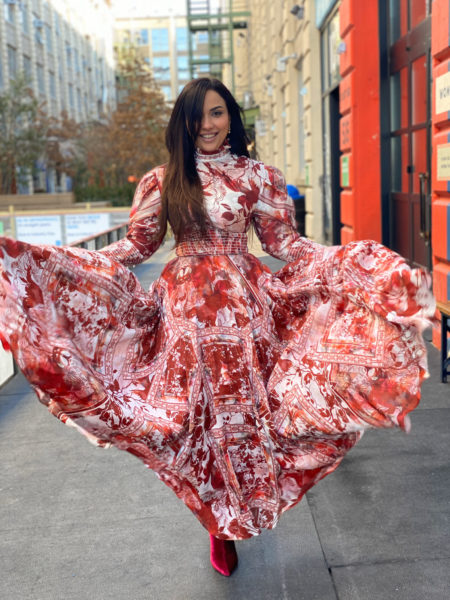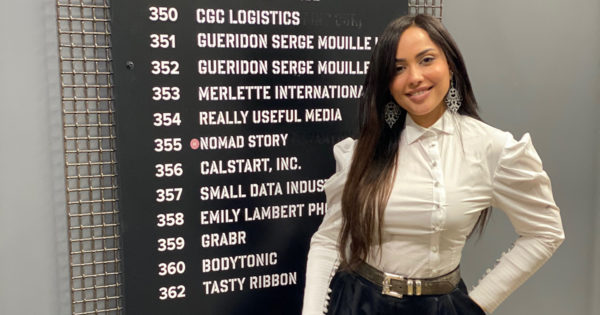Want to Know How to Rebrand Your Business? Think Customer First.

How do you get customers to trust you? How do you motivate them to take a risk and place an order when you’re a brand new startup? And how do you do this during a rebrand?
These questions aren’t unique to entrepreneur Shay Gaafar MBA’19, but her solutions may be fueling some early success for her now global, ecommerce fashion site—Nomad Story.
When There Is a Problem to Solve
Raised in the United Arab Emirates, Gaafar grew up designing her own clothing, because she wanted to be modest, yet fashion-forward.
By college age, she saw that the global fashion market wasn’t getting any closer to meeting the needs of women in the Middle East. This led her to designing and making her own clothing, and eventually, leaving her successful career in technology to attend Babson and find her passion.
Do, Learn, Pivot, Do Even Better
At Babson, students are taught to take action, learn from that experience, and take action again. So, Gaafar took a risk and pitched her business idea during a required Entrepreneurship and Opportunity course. Not long after, her first venture and fashion line, Shay Jaffar, came to life.
While she quickly gained traction, and customers, her operations weren’t allowing for the growth and market she would have liked.
“Shay Jaffar was producing at a very small scale in New York City, with a very high cost,” shared Gaafar. “It was a labor-intensive process.” Using what she learned at Babson, and her own experience as an emerging fashion designer, she decided to pivot, rebrand, and focus more on creating a community of like-minded shoppers and designers.
The result was an international, multi-brand fashion collective that matches customer with designer.
How to Rebrand Your Business

When the new business model was envisioned, it focused on the end goal. Reach as many people around the world as possible looking for modern, modest fashion, and showcase the emerging fashion designers, like Gaafar, who help fulfill this need.
“Designers love our cause and love to be a part of our community . . . (They) are excited about reading stories of women wearing their styles,” said Gaafar. On the other end, the company also has gained interest from customers “who are very interested in knowing the story of the designers.”
From free offerings, to extra products, and personal outreach from Gaafar herself—who is genuinely interested in customer experience—this people-first approach has already proven successful for Nomad Story. Since launch in late 2019, the company has welcomed new community members from the United States, to Dubai, Germany, and beyond.
“We don’t talk about a marketing plan or strategy as much as we [focus on] building trust,” said Gaafar, who coined the “Three Ts: try, trust, talk . . . Get them to try us, trust us, talk about us.”

Challenges and Advice
Above and beyond the advice she has for current students—including taking advantage of any and all resources the school has to offer—Gaafar shared some insights into her success that she hopes will motivate others pursuing entrepreneurship.
Scaling
“The best way to be able to scale faster is to have the technology in place [to do so] from day one,” said Gaafar. “We have five systems integrated with each other just to make sure orders are fulfilled smoothly and inventory management is done well.”
Customer Satisfaction
“For international orders, we deliver in three days. If it’s here in New York City, it is same-day delivery . . . [and] we do it free . . . We want to make sure [customers] can try something new without adding extra costs,” shared Gaafar.
Authenticity and Gen Z
“Everyone in the fashion market is skeptical about Gen Z,” said Gaafar, who is actually more excited than pessimistic about their buying behaviors. Gaafar says this generation loves “transparency, stories, authentic things, [and] practical, versatile styles . . . This is what we do all of the time . . . [And] if we succeed in acquiring Gen Z, we will be ahead of the market.”
She also sees a lot of value in being authentic with her designers.
“I trouble myself to meet them and to build a relationship with them,” said Gaafar. From Brazil, to Los Angeles, Spain, India, and the Netherlands, Gaafar has traveled far and wide to meet designers in person, to source their ideas, and to better build her community.
Posted in Community





